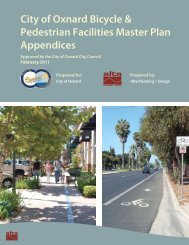View File - Development Services - City of Oxnard
View File - Development Services - City of Oxnard
View File - Development Services - City of Oxnard
You also want an ePaper? Increase the reach of your titles
YUMPU automatically turns print PDFs into web optimized ePapers that Google loves.
WATER RESOURCES TECHNICAL REPORTamount <strong>of</strong> groundwater pumping in the UWCD LAS PTP wells and the PVCWD LAS wells,and replacing that pumpage with surface water deliveries from the following:• The Saticoy wellfield project that will take advantage <strong>of</strong> increased diversions from theSanta Clara River into the Saticoy spreading grounds.• The Conejo Creek Diversion project that will divert treated effluent and natural flowsfrom Conejo Creek.The water management scenarios were simulated from 2001 to 2031 replicating 1970 to 2000hydrology. Groundwater pumpage and artificial recharge are set to wet, dry, and normalcalendar year classifications based on Santa Clara River flow. This is an improvement overthe USGS model, which performed simulation based on only wet and dry years. Foursimulations were performed, including a Base Case and three scenarios as follows:• Base Case. The Base Case did not involve any new in lieu <strong>of</strong> surface water deliveries toalleviate pumping demand on the PTP wells or PVCWD wells. The only change to wet,dry, and normal pumping demand was to reduce pumping in municipal, industrial, anddomestic wells located within the boundaries <strong>of</strong> the FCGMA by an 8 percent weightedaverage over 30 years to reach the full pumping allocation cutback <strong>of</strong> 25 percent. Thisadditional FCGMA cutback was not applied to agricultural wells because they wereassumed to either be on agricultural efficiency or have a large pool <strong>of</strong> credits (seeFCGMA Ordinance No. 8 for definition).• Scenario 1. This scenario used water deliveries from the Saticoy wellfield as in-lieudeliveries to <strong>of</strong>fset pumping demand in the PTP wells and PVCWD wells. Groundwaterlevels increased by as much as 30 feet during wet periods and 15 feet during dry periodsin PVCWD wells over the base case.• Scenario 2. This scenario is similar to Scenario 1, except that the reduction in pumping isdistributed differently among the PVCWD wells during normal and dry-year pumpingto preferentially reduce pumping in those PVCWD wells most vulnerable to highchloride concentrations. Groundwater levels increased by as much as 40 feet during wetperiods and 15 feet during dry periods in PVCWD wells over the base case.• Scenario 3. This scenario is similar to Scenario 2, except that in-lieu water delivers areadded from the Conejo Creek Diversion Project to the in-lieu water deliveries from theSaticoy wellfield. The water deliveries from the Conejo Creek Diversion only replacepumping from the PVCWD wells and are taken preferentially over Saticoy wellfieldwater deliveries. This increases the amount <strong>of</strong> water deliveries available to <strong>of</strong>fsetpumping demand for the PVCWD wells. Groundwater levels increased by as much as60 feet during wet periods and 50 feet during dry periods in PVCWD wells over the basecase. The reduced PTP and PVCWD pumping for this final scenario was accomplishedas follows:−In a wet year, all <strong>of</strong> the pumping demand from the PTP wells is replaced by waterdeliveries from the Saticoy wellfield, which amounts to 1,000 AFY. All <strong>of</strong> thepumping demand from the PVCWD wells is replaced by water from the ConejoCreek Diversion with amounts to 4,146 AFY.W112003002SCO LW1458.DOC/ 033390002 71
















